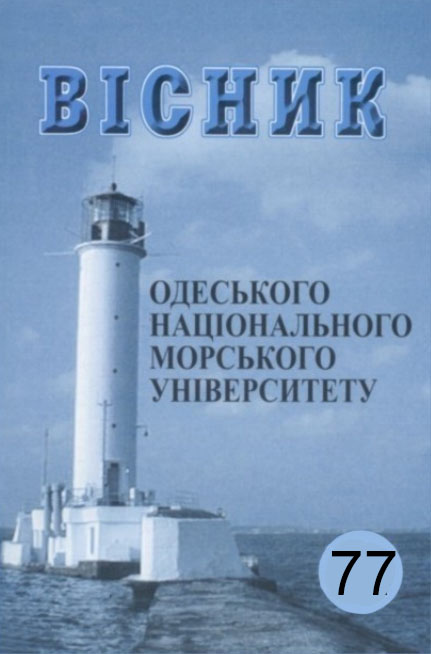Influence of thrusters’ electric motors power on the maneuvering properties of electric ships
Main Article Content
Abstract
The aim of the study is to develop a method for assessing the impact of the thrusters’ electric motors power on electric ships’ maneuvering characteristics. The power of the thrusters’ electric motors on electric ships is comparable with the power of propulsion electric motors. In maneuvering modes, all components of the ship's electric power system constantly operate in transient modes. Analysis of the impact of the thrusters’ electric motors power on the electric ships’ maneuvering properties should be carried out taking into account the joint operation of all components of a single propulsion ship complex. The assessment method is based on a mathematical model of transient modes of propulsion systems. The calculation of the hydrodynamic characteristics of thrusters’ propellers is based on an analytical method that allows taking into account the processes of their interaction with the ship's hull in unspecified modes. The method for calculating transient modes makes it possible to assess the main indicators of maneuvering quality with simultaneous monitoring of additional loads on all components of the single ship's electric power system. The results of the study show that with an increase in the power of the thrusters’ electric motors, the maneuverability of ships improves. The electric power system is not overloaded. The degree of influence of the electric motors power on the maneuverability indicators of propulsion systems depends on the speed of the vessel's exit to a curved trajectory. Regularities in the influence of the power of the thrusters’ electric motors on the maneuverability indicators of electric ships are found. Proposals are formulated for a justified choice of the power of thrusters and forecasting the maneuverability of ships taking into account the capabilities of the electric power plant to ensure them. Bibl. 14, Table 1, Fig. 7.
Article Details
References
2. Feng Yukun, Chen Zuogang, Dai Yi, Cui Lianzheng, Zhang Zheng, Wang Ping. (2022). Multi-objective optimization of a bow thruster based on URANS numerical simulations. Ocean Engineering, 2022, vol. 247(4): 110784. doi: 10.1016/j.oceaneng.2022.110784.
3. Feng Yukun, Chen Zuogang, Dai Yi, Wang Ping. (2020). An experimental and numerical investigation on hydrodynamic characteristics of the bow thruster. Ocean Engineering, 2020, vol. 209(8):107348. doi: 10.1016/j.oceaneng.2020.107348.
4. Abramowicz-Gerigk Teresa, Gerigk Miroslaw K. (2020). Experimental study on the selected aspects of bow thruster generated flow field at ship zero-speed conditions. Ocean Engineering, 2020, vol. 209(92):107463. doi: 10.1016/j.oceaneng.2020.107463.
5. Liu Hui, Feng Yukun, Chen Zuogang, Dai Yi, Tian Ximin. (2017). Numerical Study of Pressure Fluctuation for Bow Thruster. Journal of Shanghai Jiaotong University , vol. 51(3), Р. 294-299. doi: 10.16183/j.cnki.jsjtu.2017.03.007.
6. Ionut Cristian Scurtu, Valentin Oncica. (2018). Combined CFX and Struc- tural Simulation for Bow Thrusters Loading under Operating Conditions. Journal of Physics Conference Series, vol. 1122(1):012024. doi: 10.1088/1742-6596/1122/1/012024.
7. Kupraty O. (2021). Mathematical modelling of construction of ship turning trajectory using autonomous bow thruster work and research of bow thruster control specifics. Scientific Journal of Gdynia Maritime University, No. 118, June 2021, Р. 7-23. doi: 10.26408/118.01.
8. Ruth E. (2008). Propulsion Control and Thrust Allocation on Marine Vessels. Ph.D. Thesis, NTNU Norwegian University of Science and Technology, Trondheim, Norway, 2008.
9. Yarovenko V.A., & Chernikov P.S. (2017). A calculation method of transient modes of electric ships’ propelling electric plants. Electrical Engineering & Electromechanics, (6), Р. 32-41. https://doi.org/10.20998/2074-272X.2017.6.05 [in Ukrainian].
10. Yarovenko V.A., Chernikov P.S., Zaritskaya О.I., & Schumylo A.N. (2020). Control of electric ships’ propulsion motors when moving on curvilinear trajectory. Electrical Engineering & Electromechanics, (5), Р. 58-65. https://doi.org/10.20998/2074-272X.2020.5.09 [in Ukrainian].
11. Yarovenko V.A. (2020). Dynamics of propelling telectric power plants of electric ships’ propulsive complexes Development of Scientific Schols of Odessa National Maritime University: collective monograph. Riga: Izdev- nieciba «Baltija Publishing». 2020. 500 p https://doi.org/10.30525/978-9934-588-86-0.08
12. Schumylo J.M., Yarovenko V.O., Zaritskaya O.I. (2022). Dynamic similarity of electric ships’ propulsive complexes. Transport Development – Odesa, ONMU, 2022 – № 4(15). Р. 43-57. DOI https://doi.org/10.33082/td.2022.4-15.05 [in Ukrainian].
13. Shumylo Oleksandr, Yarovenko Volodymyr, Malaksianj Mykola, Melnyk Oleksiy (2003). Comprehensive Assessment of Hull Geometry Influence of a Modernized Ship on Maneuvering Performance and Propulsion System Parameters, Scientific Journal of Maritime Research (Pomorstvo), Vol 37 (2023) Р. 314-325. https://www.pfri.uniri.hr/web/en/dokumenti/pomorstvo/2023/12/13_768-Shumylo.et.al.pdf .
14. Shumylo O., Yarovenko V., Malaksiano M., Melnyk O., & Iovchev S. (2025). Methods for assessing electric ships’ maneuvering and safety indicators based on the theory of the dynamic similarity. In Studies in Sys- tems, Decision and Control (Vol. 580, Р. 235-255). Springer. https://doi.org/10.1007/978-3-031-82027-4_15 [in Ukrainian].
